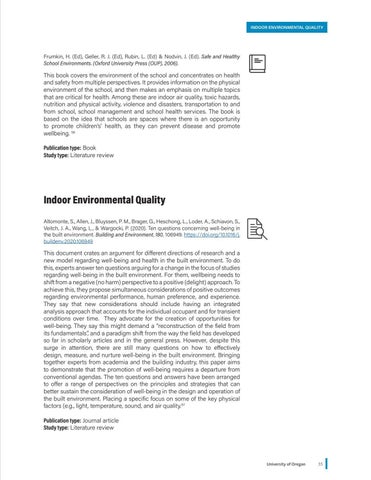INDOOR ENVIRONMENTAL QUALITY
Frumkin, H. (Ed), Geller, R. J. (Ed), Rubin, L. (Ed) & Nodvin, J. (Ed). Safe and Healthy School Environments. (Oxford University Press (OUP), 2006).
This book covers the environment of the school and concentrates on health and safety from multiple perspectives. It provides information on the physical environment of the school, and then makes an emphasis on multiple topics that are critical for health. Among these are indoor air quality, toxic hazards, nutrition and physical activity, violence and disasters, transportation to and from school, school management and school health services. The book is based on the idea that schools are spaces where there is an opportunity to promote children’s’ health, as they can prevent disease and promote wellbeing. 56 Publication type: Book Study type: Literature review
Indoor Environmental Quality Altomonte, S., Allen, J., Bluyssen, P. M., Brager, G., Heschong, L., Loder, A., Schiavon, S., Veitch, J. A., Wang, L., & Wargocki, P. (2020). Ten questions concerning well-being in the built environment. Building and Environment, 180, 106949. https://doi.org/10.1016/j. buildenv.2020.106949
This document crates an argument for different directions of research and a new model regarding well-being and health in the built environment. To do this, experts answer ten questions arguing for a change in the focus of studies regarding well-being in the built environment. For them, wellbeing needs to shift from a negative (no harm) perspective to a positive (delight) approach. To achieve this, they propose simultaneous considerations of positive outcomes regarding environmental performance, human preference, and experience. They say that new considerations should include having an integrated analysis approach that accounts for the individual occupant and for transient conditions over time. They advocate for the creation of opportunities for well-being. They say this might demand a “reconstruction of the field from its fundamentals”, and a paradigm shift from the way the field has developed so far in scholarly articles and in the general press. However, despite this surge in attention, there are still many questions on how to effectively design, measure, and nurture well-being in the built environment. Bringing together experts from academia and the building industry, this paper aims to demonstrate that the promotion of well-being requires a departure from conventional agendas. The ten questions and answers have been arranged to offer a range of perspectives on the principles and strategies that can better sustain the consideration of well-being in the design and operation of the built environment. Placing a specific focus on some of the key physical factors (e.g., light, temperature, sound, and air quality.57 Publication type: Journal article Study type: Literature review
University of Oregon
35

